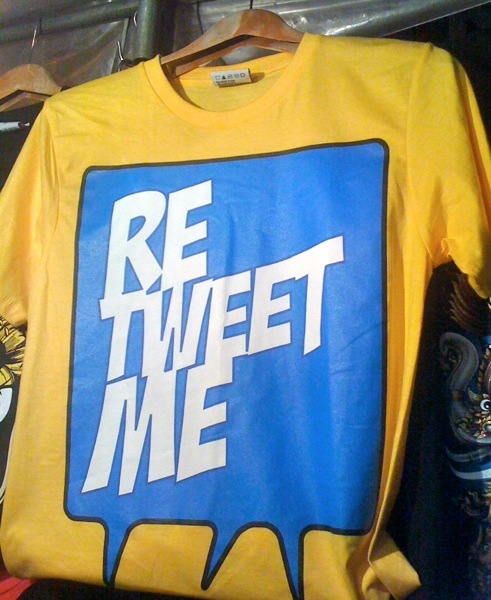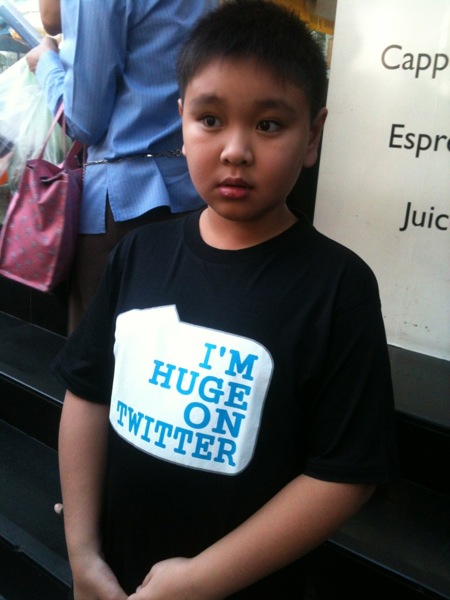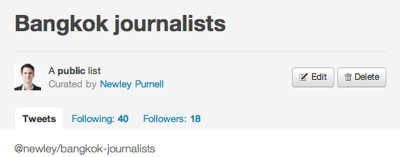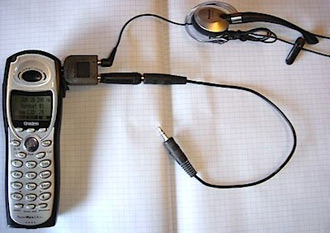
Here’s a screen grab from a promotional video for Apple’s new iPad.
Is it me, or does this look like Thailand? Or Cambodia?

Here’s a screen grab from a promotional video for Apple’s new iPad.
Is it me, or does this look like Thailand? Or Cambodia?
The AP reports today:
Thailand is welcoming Twitter’s new policy to censor tweets in specific nations where the content might break laws.
Technology minister Anudith Nakornthap said Monday the new policy was a “constructive” development. The Southeast Asian country routinely blocks websites with content deemed offensive to the Thai monarchy.
Jon Russell has more at The Next Web:
Twitter’s controversial move towards enabling the censorsing of tweets has gained the backing of its first international government, after authorities in Thailand publicly endorsed the introduction.
And The Bangkok Post ran a story on the news today.
More to come on this topic, I’m sure.
(All emphasis mine.)
I wanted to share this cell phone picture of a T-shirt I spotted at a market in Bangkok’s Silom neighborhood last night.
Yes, it says “RE TWEET ME.”
Further proof — as if any were needed — of Twitter’s global influence.

Naturally, I Tweeted the pic, and Twitter user @_JustMelissa posted the excellent image below in response.
She wrote:
@newley love it! It’s like this one. I had to stalk this kid all the way down Silom for this picture.

So there you have it: Bangkok’s Silom ‘hood is a hotbed for Twitter-focused sartorial irony. Who knew?
While researching a story a couple of weeks back, I interviewed an expert who advises hotels on how best to use social media.
He told me that some clients were starting to realize that social media is here to stay, and that they had better start making good use of it.
Social media is here to stay.
That phrase stuck with me.
It’s tempting to think about social media in the short term, since it’s a relatively new phenomenon. Indeed, new services seem arrive quickly and sometimes fall out of favor. MySpace, for example, was once commanding international headlines, but its popularity has fallen off sharply.
But clearly, Facebook and Twitter — and now Google Plus — are gaining new users rapidly. And blogs, forums, and wikis continue to flourish. To wit:
Yes, there are important questions to ask here, like whether or not social media is actually beneficial for its users. This is a topic for another blog post, perhaps.
For now, I wanted to share the following sketches to illustrate how my thinking about the way I interact with the Web has changed over the years.
In an attempt to make sense of my own social media practices, I have periodically sketched out, on 4×6 inch index cards, how I use the Internet. But first, two caveats:
Okay. Here we go:
(Click the image for a larger version.)
As you’ll see, I labeled this “My Social Media Ecosystem,” and I drew a line in the left corner separating my “public” and “private” spheres.
In the upper left corner, I listed three online communities with which I was once involved but no longer use.
These include Mixx.com, which was a site that allowed users to set up pages and bulletin boards to share information on various topics; GoodReads, the well-known book-centered community; The Glove Bag, a community for soccer goalkeepers; and Emory Alumni, my alma mater’s community site.
In the middle of the diagram is my site, Newley.com, which you’re reading now. Overlapping the upper left and right corners are my Flickr page on the popular photo sharing site, and my Twitter account.
I also drew a link between my blog and my personal Facebook account.
In addition, I created a line between my site and my “blogroll,” which was once a long list of sites I linked to but is now a more focused list on my links page.
I also placed question marks around three social sites I was thinking about using but never embraced: FriendFeed (RSS/feed aggregation), Tumblr (microblogging), and Vimeo (video).
And finally, I listed the ways I collect input on the Web: through RSS, email, podcast, and Twitter feeds.
All in all, it is a somewhat jumbled diagram.
(Click the image for a larger version.)
Again, this one is called “My Social Media Ecosystem.”
Here, I charted my “level of engagement” along the “y” axis, with levels of public or private networks listed on the “x” axis.
Newley.com is in the upper left, as I regarded it as the Web entity with which I am most involved. I still feel that way.
Similarly public, but with less interaction on my part, are the blogs that I read and the Flickr users I track.
I estimated Twitter as being equal in terms of level of engagement as my blog, but it’s further along the “x” axis. While my Twitter feed is just as public as Newley.com, it’s slightly more closed in that users must sign up with the site to participate in discussions.
I listed Facebook as more private but involving less of my personal engagement. This is curious, since Facebook, of course, centers on personal relationships. But I consider my activity on that site as being less important than here, on my public Web site.
Skype shows up on this diagram as being private but involving less engagement, as I use the service not only for calls and video, but also for instant messaging.
And finally, I’ve listed podcasts here, though I’m not sure that they constitute social media. I have a high degree of engagement with the podcasts I listen to, but there’s no back-and-forth interaction, so the format feels largely broadcast in nature.
In retrospect, this diagram doesn’t seem especially meaningful, since levels of engagement and public or private measurements, as charted on the axes, aren’t valuable metrics.
(Click the image for a larger version.)
I used a different name for this one: “The Web and Me.”
I’ve used a venn diagram format here, with my site occupying the most prominent spot, in the middle.
Flickr overlaps a bit, as I occasionally host blog images (like these diagrams) there.
Twitter has a larger overlapping section, since I frequently post observations and links there throughout the day. And my Tweets have a more prominent place on Newley.com, since they can be seen on the right side of every page.
Facebook has a Flickr-sized overlapping segment, since I have a box on Newley.com inviting people to “like” my newly created public Facebook page.
And finally, on the left, you’ll see a circle for what I call “The Rest of the Web”: email, RSS, and podcasts.
This diagram feels the most natural to me, which shouldn’t be surprising since it’s the freshest.
This site contains links to my work, my contact information, and my ongoing posts about the things that interest me. I suspect that this will continue to be the case in the years ahead.
This may be a function of my evolving comfort with social media. Perhaps I’m not as concerned now with how “engaged” I am with a particular site, or whether or not it’s public or private. I have come to understand these factors and don’t dwell on them.
Looking ahead: If, as the expert told me, social media is here to say, what might these sketches look like in five or ten years? Or in 20 or 30 years?
I look forward to your thoughts.

Just a quick note, in these times of ongoing Thailand-Cambodia clashes, that I maintain a public Twitter list of Thailand journalists and commentators.
There are currently 40 members. You’ll find print and TV reporters, both foreign and Thai, as well as various writers, bloggers, and other observers here. The list is, I hope, a helpful resource for those looking for timely and credible information.
View Map of People on Twitter in Thailand in a larger map
Richard Barrow (@RichardBarrow) has created a Google Map of Thailand Twitter users. Could be a helpful resource if you’re looking for tweets from various parts of the country.
A quick note to point out that Chiranuch Premchaiporn, director of the independent Thai news site Prachatai, was arrested Friday and held for several hours for allegedly running afoul of Thailand’s Computer Crime Act and committing lese majeste, or insulting the royal family.
The charges reportedly stem from a 2009 complaint that offensive comments — though they were subsequently removed — had been posted on the site. Chiranuch is now out on bail but faces a 50 year prison sentence.
AP has a story — “Rights groups denounce arrest of Thai webmaster” — and Andrew Marshall has a blog post called “A Dangerous Woman.” And here’s a Bangkok Post op-ed by Professor Thitinan Pongsudhirak in which he touches on her case; the piece is called “Thailand and its hybrid authoritarianism.”
I suggest checking out all three items.
Readers of my recent Chronicle of Higher Education story about Thailand will recall that Chiranuch weighed in on Thai universities.

Note: This is cross-posted to Siam Voices, a new group-run Thailand blog at Asian Correspondent.
Arguments over stipulations in the Thai constitution. Court rulings. Frustrated investors. Beguiled local people.
Sound familiar?
No, this isn’t the Map Ta Phut industrial estate case. It’s a different snafu entirely — but one with certain similarities.
This high-tech imbroglio has to do with Thailand’s lack of a so-called 3G mobile network. In short, 3G — or third generation — technology allows cell phones to use more bandwidth. This is useful — and some would say necessary — as people increasingly use Web-capable smartphones like the iPhone and Google’s Android phone for work and play.
Most of Thailand’s Southeast Asian neighbors already have 3G capabilities, and 4G is already being used elsewhere in Asia.
But on Thurs., Thailand’s Supreme Administrative Court ruled to halt planned bidding for 3G licenses, resulting in a major setback in efforts to bring a faster mobile network to the country. The Bangkok Post has the details, and Thailand’s official MCOT news agency says:
Thailand’s Supreme Administrative Court on Thursday upheld the Central Administrative Court’s injunction to suspend distribution of the third generation (3G) wireless service, saying the National Telecommunications Commission (NTC) was not authorised to award the 3G licence.
…
The Supreme Administrative Court reasoned that the NCT’s criteria for granting 3G licences was illegal and the auction process, if continued, could cause severe damage.
It also pointed out that the 3G service which was in its first phrase could be offered to a small, limited network and that it takes at least four years to cover the whole country, so that suspending it currently will not be an obstacle to the future use of the technology.
The court ruled that the 3G auction should be held after the National Broadcasting and Telecommunications Commission (NBTC) is set up.
CAT Telecom filed a complaint against the NTC to block its 3G auction last week. The three bidders–Advanced Info Service (AIS), DTAC and True Move–have been informed of the court’s decision.
The Central Administrative Court earlier handed down an injunction to halt the 3G licence bidding process until the NBTC was established as prescribed under the 2007 Constitution, saying the NTC was not empowered to allocate the frequencies.
Got that? Indeed, the issue is complex.
As Bloomberg explains, the current impasse — like the Map Ta Phut situation — reflects, to some degree, the ongoing unintended consequences of the 2006 military coup:
Thailand’s failure to auction licenses for high-speed mobile-phone services this week may have been sealed four years ago, when the military ousted Thaksin Shinawatra from power and began drafting a new constitution.
The nation’s highest administrative court yesterday said a constitutional review is needed to decide whether regulators have authority to conduct a sale, causing phone company stocks to fall on concern revenue from new services will be delayed. Last year, shares in industrial companies slumped after a similar decision halted 76 projects approved by the government.
And:
“This just highlights the economic cost of the coup and the legacy of military rule that the country is still paying for,” said Andrew Yates, head of foreign sales at Asia Plus Securities Pcl, Thailand’s third-biggest brokerage by market capitalization. “The biggest loser is the customer.”
And finally:
“The problem is that the laws to implement the constitutional arrangements haven’t been passed,” said Alastair Henderson, a Bangkok-based partner at Herbert Smith LLP. “The broader impact is foreign investors looking at Thailand and saying these legal uncertainties make me wonder whether that’s the place I want to put my major Southeast Asian investment.”
Some estimates indicate that at this point, 3G may not be implemented in Thailand for another two years.
Ironically, Apple’s new iPhone 4 — the successor to the iPhone 3G — went on sale here in Thailand on Thursday night, and eager consumers snapped up the new gadgets.
For further reading on 3G in Thailand, there’s this Bangkok Post story from Sept., 2009; this Bangkok Pundit post that explains the situation and the players involved; and this Reuters story.
(All emphasis mine.)
(Image via the Bangkok Post.)
From today’s WSJ: Mobile Service Targets Cambodia’s ‘Unbanked’:
How do you roll out a banking service in a place where most people don’t have bank accounts?
Australia & New Zealand Banking Group Ltd. tackled that question in developing WING, a banking and payment system it launched in Cambodia early last year.

Cool Tools: Hands-Free Phone-Interview Setup:
It’s a serious issue in contemporary journalism: how do you record phone interviews while using a headset?
The post points to the Olympus TP-7 telephone recorder and this more elaborate setup (pictured above).
Related Newley.com post: Some thoughts on audio recorders.